The Why Factory (T?F), TU-Delft
17 - 23 May 2009
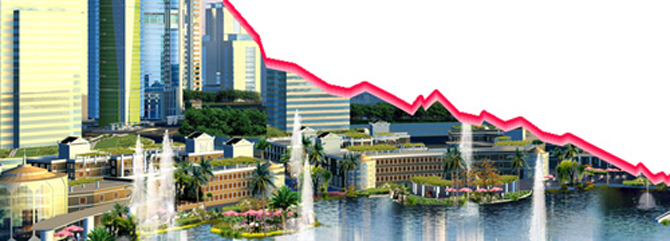
The T?F studio at ANCB was the first one in a series of workshops, the opener of the platform. The participants were international students from TU Delft, joined by the students from Universität der Künste Berlin.
The studio was constructed around a series of realities resulting from the current financial crisis. The studio aimed at debating and visualising new possibilities that the crisis might open to the city, as well as to the discipline of architecture itself. How to use the crisis as a momentum for change? Entitled ‘ After the Crisis’ the brief asked students for visions of the future Berlin.
Each project, therefore, became a hypothesis constructed around projected consequences of the current economic downfall. Using the current state of affairs as a starting point, the projects, however, intendened to paint unexpected scenarios assuming radical transformations of the city and society.
The projects and debate surronding them, raised a number of issues. How to position the discipline against the urgencies of the modern world? How to reconstruct a collective dimension within architecture? How to reinstall the necessity for large scale visions? Berlin, with its dramatic urban history turned out to be the perfect ground for such an exercise.
Staff: Winy Maas, Felix Madrazo, Alexander Sverdlov
Guests critics: Adrienne Göhler, Armand Grüntuch, Theresa Keilacker, Markus Miessen, Lukas Feireiss, Regula Lüscher, Jacob Tigges, Thomas Willemeit, Theo Deutiger, Christopher Dell
Students: Purcy Marte, Eric Haan, Bas van der Horst, Michiel van Loon, Tera Dhanamum, Hans Larsson, Terpsihori Latsi, Felicity Brouwers, Teresa Sue-Chu, Jan Twifler, Katja Behr, Gloria Sabate, Felix Heisel (UdK Berlin), Jonas Klock (Udk Berlin), Michael Wierdak (UdK Berlin), Stephanie Kalläne (UdK Berlin), Philipp Keiss (UdK Berlin), Jan Müllender (UdK Berlin)
Michael Wierdak, Teera Dhanamun, Terpsichori Latsi
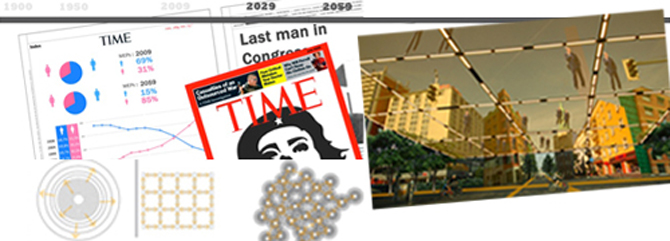
The financial crisis of 2008 found governments unable to control their economies, leading to the collapse of the macro credit and rating systems. Micro credits were already in existence, but it was not until the failure of macro credits that they took control of the financial world. Importantly, micro credits were given mostly to women due to their proven interest in long-term profit.
Women were now in charge of the economy and society therein. One of their major changes was the replacement of democracy with micro-democracy, introducing economic measures which, especially after 2025, helped the world to recover from the crisis. In the new system every person was allowed to take part in the governance of his or her region.
Every form of power in the city was deconstructed: big business and administration districts were distributed throughout the urban net, thereby improving accessibility and visibly reducing building scale. Central and suburban areas were abolished. The city was transformed into a multi-center net, with the same provisions everywhere, without cars and easily accessible by foot. Diversity enlivened every area making it safer, more efficient and active 24 hours per day.
Stephanie Kalläne, Purcy Marte, Jan Twifler
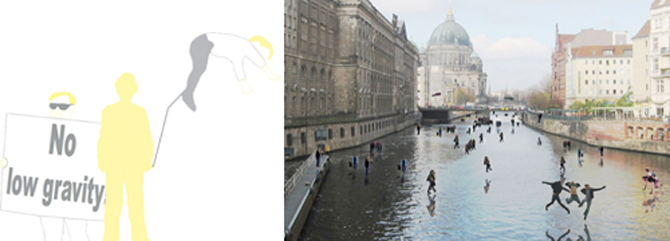
Berlin, 13 May 2017 – Siemens and TU-Berlin jointly announced their ‘Low-Grav Distribution System’ project. The project aimed to explore the groundbreaking possibilities of electromagnetic hyper-conductor acceleration.
“We did not foresee this outcome” (Mark Maxwell referring to low gravity tests)
Berlin, 3 Feb 2048 - in response to recent inexplicable events, Mark Maxwell, coordinator of de hyper conductor research project, spoke at a press conference. This technology holds huge potential for applications other than just distribution pipelines. Nike 'gravity' provides the ability to be adjusted according to weight and activity. Liberated from gravity, plants grow wider and taller. Slender structures beyond your wildest dreams. Add a new dimension to your sport activities! Forget expensive machinery; low-gravity unleashes secret powers. Up to 6 times more living surface in your apartment; no physical changes required. Continuous spaces rather than stacked levels. Eliminate stairs and lifts. Nature will adapt to low-gravity in the shortest time. No more problems finding car parking. No rainfall and less wind in low-gravity zones - rain just runs down the border zones like on an umbrella. Low gravity inspires visionaries.
Felix Heisel, Bas van der Horst, Michiel van Loon
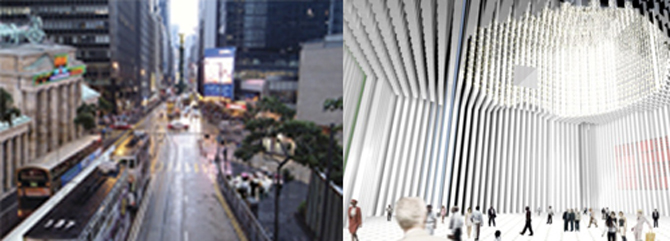
Think Negative. If only a small period of financial recovery occurs, Berlin will not survive. Think Negative proposes a strategy for cities to deal with the consequences of the financial crisis.
The Brandenburger Tor in Hong Kong. Instead of building replicas - e.g. Rialto Bridge has been re-created in thirty countries - Berlin started selling their landmarks. Authentic monuments were the next natural step for the leisure industry.
So sell it... But what was gained? Profits were not just used to repay debts but also to provide for a new city. Selling the Jewish memorial for instance provided funds to build a hospital, 15 schools and 3 cinemas. Improved amenities attracted more inhabitants thereby increasing density.
Scaffolding. Demolition scaffolding became the framework for the new city. The negative forms of the building remain as monumental space.
The city rises. The positive city rose…from the negative: negative thinking to construct a positive city. The built city acted as a bank where every piece of the built environment had sale value. The city of Berlin changed drastically. The new physical and programmatic layers built the skyline. Negative spaces linked the new city with its past.
Felicity Brouwers, Philipp Keiss, Hans Larsson, Jan Müllender
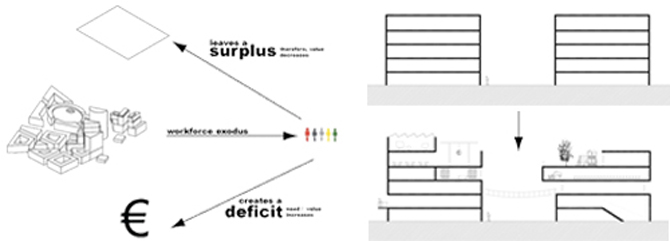
Berlin's flux(c)ity concept resulted from 2008's unprecedented financial crisis. Failed financial bail-outs left government institutions and their investments incapable of recovery. Potsdamer Platz, an icon of the nineties economic boom was abandoned; the rest of Berlin a ghost town of derelict office towers and abandoned shops.
How could a city find new life, after being reduced to a condition of such paralysis?
The solution was in the only remaining resource: space. In 2037 the pilot flux(c)ity concept was initiated in various parts of the city. A grid of private lots provided small businesses and artists with spaces they could use as needed. It was permitted to radically redesign each lot. In this re-scaling of the city, whole buildings took on the function of traditional city blocks, and circulation spaces such as stairways acted as public streets between the private parcels.
Slowly the city began to fill up again - pixels of edited space enlivening the facades of the formerly empty buildings. Now it is hard to imagine Potsdamer Platz before the flux(c)ity programme, but it is rewarding just to walk its streets - to be struck by the complex beauty of this iconic part of Berlin.
Katja Behr, Gloria Sabate, Jonas Klock
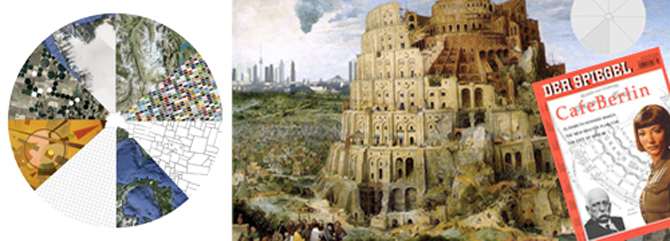
We hypothesise that the crisis will continue to worsen. Kerosene prices go through the roof. Air companies go bankrupt. Those surviving raise their prices. Travel becomes an unaffordable dream. Governments start investing beyond the city. “Holidays within the city!“ In 2015 a masterplan is proposed to improve the landscape and thereby the quality of life. Berlin becomes like a museum, its centre surrounded by different exhibition spaces. The masterplan is influenced by the idea of the garden cities with different themes in each of its 8 new divided plots. These plots are formed by the extension of the existing main roads. Circulation around the plots can be done from the center to the outside, but it can also been done as a radial circulation through different experiences. With this plan we achieve an increase of 23 times the amount of landscape per inhabitant. We are recreating 8 different scenarios and landscapes like a glacier, a zoo, a forest, an amusement park, a new Babylonia, a sea and the mountains.
Teressa Ellen, Erik de Haan
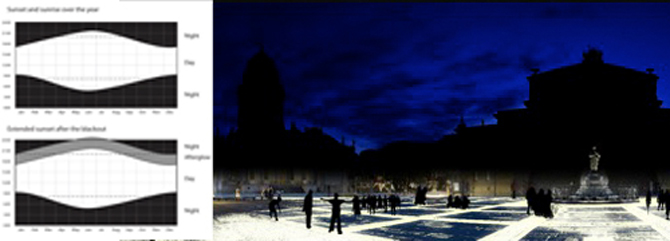
Unable to pay its energy bill, the financial crisis soon became an energy crisis for the city of Berlin. Electricity was turned off from 8pm-8am. Authorities sought solutions as darkness became danger. Citizens huddled about laptops, transistor radios and portable lights as batteries faded. Energy saving soon became a way of life.
In 2009, artist Olafur Eliasson paved a public square with glow-in-the-dark stone, inverting the built environment as lights in surrounding buildings were switched off. Buildings became meaningless; the square became the focus of activity. When the energy crisis hit Berlin, this concept was adopted in shops, restaurants, clubs and parks. Public life took over the streets, slowly spreading throughout Berlin.
Authorities took notice, re-paving Berlin's main roads and public squares, thus extending daylight's 'after-glow'. Material research continued. Phosphorescent deep-sea bacteria became an entire industry, setting aquariums, rivers and indeed whole oceans aglow. Electric light became redundant as bacterial technology took over. The whole earth became its own light source.
More Info

